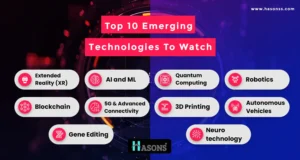What is Technology and Why Emerging Tech Matters
Technology shapes our world. From the steam engine to smartphones, new technological developments have fundamentally changed how we live and work. As we move further into the 21st century, a new wave of groundbreaking technologies is emerging that promise to be equally revolutionary.
Understanding emerging tech trends is crucial for keeping up with our rapidly accelerating world. Whether you’re an entrepreneur looking to harness innovative tech, an investor trying to identify the next big thing, or simply someone interested in where the future is headed, getting familiar with cutting-edge technologies makes it easier to prepare for what’s to come.
What Qualifies as Emerging Technology?
Emerging technologies are new technological developments that have the potential to significantly influence the world in the near future. Typically, emerging tech refers to breakthroughs that are still in relatively early stages of research and development, but show immense promise.
Some key characteristics of emerging technologies include:
- Novelty: Emerging tech introduces new concepts, ideas, or capabilities that previously did not exist. It often represents leaps rather than incremental improvements.
- Growth potential: Though still evolving, emerging tech displays rapid growth rates and is poised to expand significantly in scale or application.
- Transformative potential: By enabling new products, processes, or even whole new industries, emerging tech has the power to profoundly disrupt status quos and transform lifestyles.
Importantly, the label of “emerging technology” is fluid. As innovations mature from cutting-edge concepts to widespread adoption, they graduate from the category of emerging tech. The technologies considered emergent also shift with the inexorable march of human innovation.
Top 10 Emerging Technologies To Watch
Many technological revolutions are brewing that will shape the 2020s and beyond. But the following 10 emerging tech trends deserve special attention in the coming years thanks to their world-shaking potential:

1. Extended Reality (XR)
Extended reality (XR) refers collectively to all immersive technologies, including virtual reality (VR), augmented reality (AR), and mixed reality (MR), that enhance our perception of reality.
XR transports users to digitally created environments (VR), overlays digital elements onto the physical environment (AR), or blends both physical and virtual worlds (MR) – thereby pushing human experience beyond ordinary reality.
With expanding applications across training and simulation, healthcare, design, manufacturing, marketing, entertainment, and more, XR use cases are multiplying rapidly. The global XR market, valued at $25 billion in 2021, could grow over 10x to reach $400 billion by 2025, per PwC estimates.
2. Artificial Intelligence and Machine Learning
Artificial intelligence (AI) development continues accelerating, enabling systems to perform tasks normally requiring human intelligence – visual perception, speech recognition, decision-making, language translation, and much more. Meanwhile, machine learning, a subset of AI allowing algorithms to learn automatically from data patterns, makes it possible to rapidly expand and enhance Chatbot AI capabilities.
“AI is the new electricity” – Andrew Ng, computer scientist and AI pioneer
The global AI market size Could Surpuss $500 billion by 2028. Increasingly powerful AI and machine learning drive progress across everything from healthcare to autonomous driving.
3. Quantum Computing
Conventional computers store data as binary digits (bits), encoded as either 0 or 1. Quantum computers leverage quantum mechanics phenomena to develop exponentially faster processing power using “qubits” that represent 0 and 1 simultaneously, enabling complex calculations not possible with traditional computing.
While early stage, quantum holds revolutionary potential. Future quantum capabilities could facilitate medical discoveries, optimize complex systems like supply chains or financial modeling, break current encryption schemes, and more. Quantum computing remains a key emerging technology to track in the 2020s and beyond.
4. Robotics
Robotics technology development is accelerating across industries from manufacturing to healthcare, fueled by converging breakthroughs in sensing, movement, AI, and machine learning. Industry spending on robotics, nearly $100 billion in 2022, will more than double to top $230 billion by 2025, per IDC.
In particular, advancements in areas like computer vision, adaptive motor control, tactile sensors, and AI chips that operate similarly to human brains will drive autonomation of physical tasks once reserved for human workers alone. Robotics will be a major tech disruptor to watch in the years ahead.
5. Blockchain
Blockchain provides decentralized, distributed ledger technology to record transactions or data in encrypted “blocks” across a network of computers. This creates secure, transparent, tamper-proof records without needing third-party validation – streamlining transactions and reducing risks of manipulation.
Current blockchain use cases focus on financial transactions, particularly cryptocurrencies. However, over 50% of global companies now explore blockchain solutions for supply chain optimization, health records, digital identities, intellectual property protections, and more, signaling the technology’s widening applicability.
6. 5G & Advanced Connectivity
The rollout of high-speed 5G wireless networks, alongside expansions in satellite mega-constellations like SpaceX’Starlink and progress toward 6G capabilities, will realize faster, more reliable, and higher capacity communication networks. These connectivity advancements will enable key emerging tech trends like Edge computing while accelerating digital transformation across industries.
7. 3D Printing
Also called additive manufacturing, 3D printing builds objects by printing material layer after layer based on digital models – empowering on-demand, decentralized manufacturing with applications from construction to bioprinting human organs.
With declining printer costs and new printable materials like wood, metal, and graphene, 3D printing could grow over 5X from a $15 billion market in 2021 to top $80 billion by 2028, per Fortune Business Insights.
8. Autonomous Vehicles
Self-driving car market development persists through an ambivalent public reception. However, autonomous trucks and local delivery see greater near-term potential to address transport inefficiencies and safety issues.
Investments in autonomous driving doubled in 2022, suggesting the space remains optimistic despite tech hurdles. Advances in AI chips, sensor fusion, and edge connectivity will ultimately enable autonomous mainstream adoption, projecting to at least a $500 billion market by 2030.
9. Gene Editing
Powerful new gene editing techniques like CRISPR allow quick, precise modifications to DNA sequences – with promising applications across healthcare, agriculture, conservation, and more. However, significant ethical concerns remain regarding irreversible human germline editing.
Global gene editing market revenue could grow over 15% annually – from $4.1 billion in 2021 to $34 billion by 2030, per Precedence Research. Healthcare applications, like developing treatments for genetic diseases, drive most market demand as precision editing tools improve.
10. Neurotechnology
Neurotechnology leverages insights into brain science to develop technologies interfacing with the human nervous system. Promising applications aim to restore sensory capabilities, enable thought-powered device controls, enhance cognitive functions like memory, or detect emotional states and mental health disorders.
Facebook’s pivot to Meta signals surging interest in brain-machine interfaces and their future VR/AR capabilities. But reports of potential mental health risks from existing consumer EEG headsets like Halo Neuroscience also underscore the need for ethical precautions as neurotech advances.
Why Emerging Tech Matters
Emerging technologies warrant attention because they are spearheading radical change. The innovations explored in this guide – from AI and blockchain to autonomous vehicles and gene editing – all demonstrate world-altering potential, for better or worse.

Understanding key emerging tech trends helps individuals, businesses, nonprofits, and governments better prepare for social and economic shifts underway. Those recognizing revolutionary implications early can harness innovations strategically, while ethical oversight helps balance promises and perils.
Ultimately, technological change is inevitable. By tracking cutting-edge emerging tech developments, we gain foresight to navigate oncoming disruption – and opportunity.
Now, understanding this concept is simple and entertaining on Hasons. By using Hasons website you can always stay one step ahead in your job, business or studies by purchasing New Age Desktops and All in One Desktops, i3 Intel Core Processor Desktop starting from 15000/-. Monitors, CPUs, Gaming Desktop are also available. Register on Hasons and order your Tech Partner Now. Get exciting offers and benefits on your every purchase. Contact us so our support team will guide you in purchasing your right Tech Partner.
| For updates in the Emerging Technology, read Hasons Blogs. Some of them are as follows: | ||
| Computer Architecture and Organization | Network Security | |
| Phases of Generations of Computer | Network Infrastructure | |
Emerging Technology
- What are the big 5 emerging technologies?The “big 5” emerging technologies with truly transformative potential include:
- Artificial intelligence (AI)
- Blockchain
- Internet of Things (IoT)
- Robotics
- Extended Reality (XR)
- What are the examples of emerging technology?Examples span everything from the latest AI chips and quantum computing advances to bioprinting, smart cities, self-driving vehicles, renewable energy innovations, and beyond. This guide details key emerging techs across computing, connectivity, manufacturing, transportation, healthcare, and more.
- What are emerging technologies in 2023?Top emerging technologies as we enter 2023 include additive manufacturing (3D printing), autonomous driving, drones, gene editing tools, neurotechnology, renewable energy storage, space technologies, virtual reality, wearable technology, and more - all outlined in this future-focused guide.
- What are the 8 emerging technologies?Eight major emerging technology categories include:
- Artificial Intelligence (AI) & machine learning
- Blockchain & cryptocurrencies
- Internet of Things (IoT) networks
- Autonomous vehicles
- Drones
- 3D printing
- Nanotechnology
- Biotechnology
- What are 3 emerging trends in technology?Three rising technology trends to monitor are:
- Extending connectivity - 5G and low earth orbit satellite networks
- Advancing computer capabilities - quantum, edge computing
- Expanding realities - virtual, augmented, and mixed reality

One Reply to “Emerging Technology”